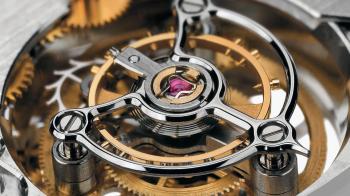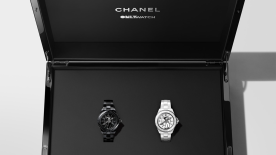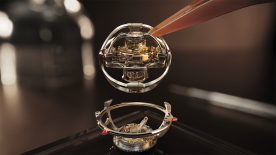In 2013, Blancpain decided to achieve a double feat by equipping a timepiece with two different types of flying tourbillon. As a bonus, this rare piece of craftsmanship also features a wealth of subtle details.
Blancpain reintroduced the tourbillon to its collections back in the 1990s, but in doing so adopted a different approach from that of other brands. At that time, tourbillons were all built on the same model, with a balance, cage and bridges all rotating around the same central, vertical axis. Instead, Blancpain decided to position the balance and escape-wheel off-centre, on either side of a balance-wheel bridge curved in a shape resembling an anchor – and to make the mechanism a flying tourbillon, allowing the structure to be admired. Then in 2008, under the leadership of Vincent Calabrese, at that time the driving force in the construction of its in-house movements, Blancpain decided to use the carrousel, often referred to as the karussel.
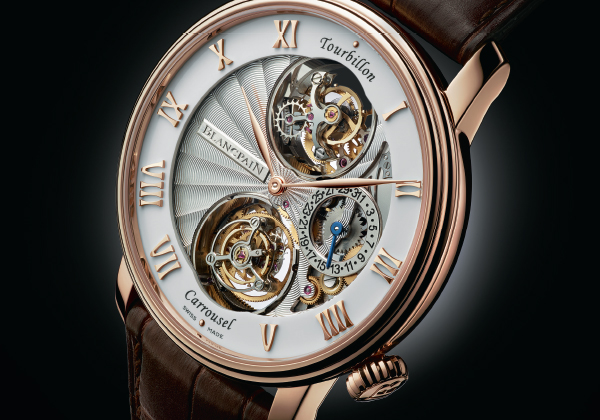
Ways and Means
‘Carrousel’ in this context doesn’t refer to some sort of merrygo-round movement with components revolving like so many horses on a fairground ride, but to a variation on the tourbillon invented in 1892 by Bahne Bonniksen, a Danish watchmaker living and working in England, and also used by V. Calabrese in his own creations in the 1990s. The difference from conventional tourbillons is that instead of the energy from the barrel powering an escapement which in turn propels the cage around a fixed wheel, in the carrousel power is passed on to the escapement and cage by two separate wheels, requiring a small internal differential to do so. In addition, the entire mechanism in question is mounted on a moving wheel. While the two movements are thus subtly different, they both achieve the same result, since the underlying idea in both cases is to make the balance rotate.
Different Cages
Blancpain took care to make the two different variations look very different, too, with an off-centre tourbillon and a carrousel based on a concentric, layered construction – quite the opposite of what might be expected. It was Blancpain’s way of thumbing its nose at self-proclaimed tourbillon experts at a time when tourbillons were still a relatively obscure phenomenon. For the avoidance of all doubt, the components’ functions were marked on the dial; anybody able to read could thus tell them apart… And so it was that the two variations came to be found in the same movement. The 2322 calibre powering this Le Brassus Tourbillon Carrousel uses a flying “cantilevered” structure for both the tourbillon at 12 o’clock and the carrousel at 6 o’clock, each equipped with a flat silicon hairspring.
Layout
At just 5.85mm thick, the calibre is quite slim and features two entire gear trains, each with its own power reserve. To wind them both at the same time, Blancpain devised an internally toothed rack that rotates when the crown is activated. This travels round the movement, meshing with both barrels at once as it does so. Each barrel is powerful enough to ensure Blancpain’s usual seven-day power reserve, displayed on a graceful gauge on the rear of the movement.
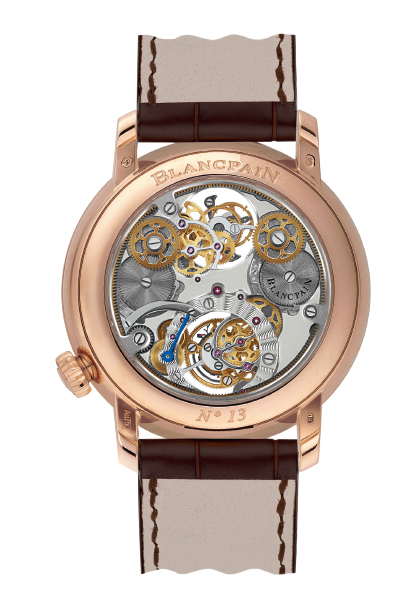
Getting it all together
Ultimately, the action of the twin regulators is harmonised by a differential gear train which transmits the average rate of the two to the time display. Whereas the two organs were originally located at 11 and 5 o’clock, the movement of the Le Brassus Tourbillon Carrousel has been rotated through a few degrees, realigning them along the vertical axis – with the result that the crown is at 4 o’clock, the symmetry of the dial having prevailed over that of the case.
Finishing touches
The finishings are done to the same high standard as the rest. The double-gadrooned Le Brassus case (which now goes by the name of Villeret) houses the very large calibre. To do so, its diameter has been increased here to 44.6mm, but since the movement is relatively slim (especially considering its complexity and power reserve) the model only needs to be 11.9mm thick. The sense of slimness is enhanced still further by the caseback with its curving bassine-type shape. In 2013, there were other models that were far more spectacular yet had far less substance. The plate is guilloched, featuring a sunray pattern that is so radiant and exquisitely crafted that it serves as a dial, clearly visible at the centre of a white, Grand Feu enamel hour chapter ring on which Blancpain has placed beautifully-styled, curved Roman numerals. The overall impression is of a timepiece that achieves several gymnastic feats while instilling a hint of irony. Like any artefact, it sends a powerful message.
*This year GMT Magazine and WorldTempus have embarked on the ambitious project of summarising the last 20 years of the Tourbillon in The Millennium Watch Book - Tourbillons, a big, beautifully laid out coffee table book. This article is an extract. The Millennium Watch Book - Tourbillons is available on www.the-watch-book.com, in French and English.
